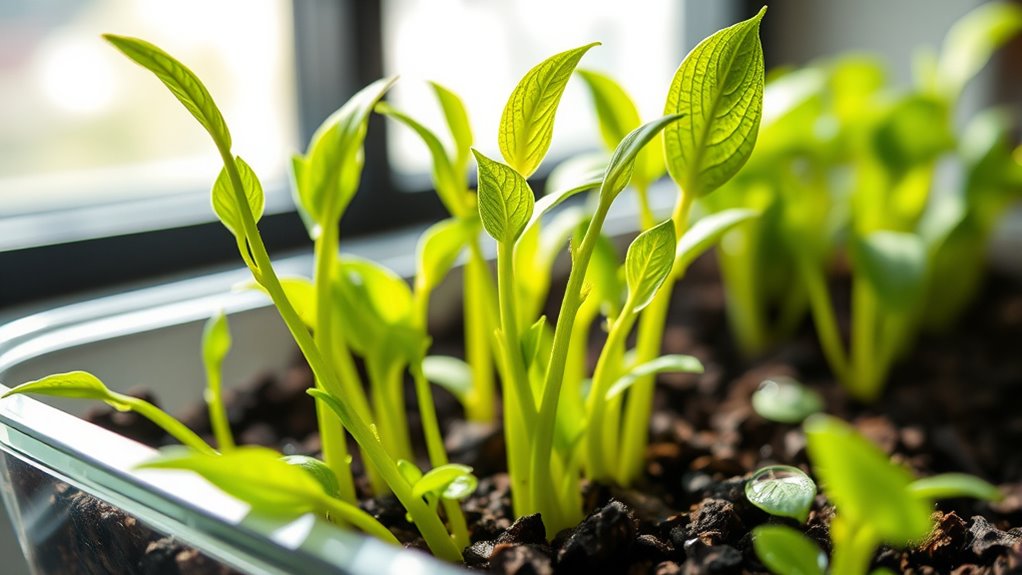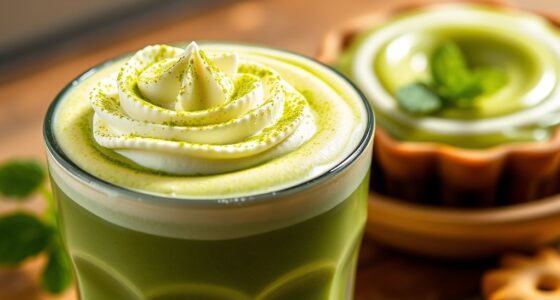Growing fresh wasabi at home can be rewarding, but it requires dedication. You’ll need to keep the water clean and cool, control pests, and be patient as it takes up to two years to mature. The effort is significant, but the vibrant flavor and freshness make it worthwhile. If you’re willing to stay committed to proper care and environmental conditions, you’ll discover how rewarding cultivating your own wasabi can be.
Key Takeaways
- Growing wasabi at home requires maintaining cool, clean, and flowing water for optimal plant health.
- It involves a lengthy cultivation period, often up to two years, demanding patience and consistent care.
- Pest management and hygiene are essential to prevent infestations and ensure healthy growth.
- The effort results in high-quality, fresh wasabi that rivals store-bought varieties in flavor and aroma.
- For dedicated hobbyists or culinary enthusiasts, the process is rewarding but may be challenging for casual growers.

Growing fresh wasabi can be a rewarding but challenging process that requires patience and attention to detail. While it’s tempting to envision a lush, green patch of wasabi thriving in your backyard or indoor setup, the reality is that cultivating this plant demands specific conditions and diligent care. One of the most critical factors is water quality. Wasabi plants thrive in cool, running water, so ensuring a steady flow of fresh, clean water is essential. Poor water quality, contaminated with chemicals or pollutants, can inhibit growth or even kill your plants. You’ll need to monitor water sources carefully, avoiding stagnant or polluted water that could introduce harmful bacteria or pests. Using filtered or spring water is often recommended to maintain ideal conditions, especially if you’re growing wasabi indoors or in an area with questionable water sources. Proper water quality management is crucial for healthy wasabi development. Pest control is another essential aspect of successful wasabi cultivation. While wasabi isn’t highly susceptible to pests, certain insects like aphids or slugs can cause damage if left unchecked. These pests are often attracted to the lush leaves and can quickly spread diseases or weaken the plant if not managed early. Regular inspection of your plants is necessary to catch infestations before they become severe. Organic pest control methods, such as introducing beneficial insects like ladybugs or using natural repellents, work well to keep pests at bay without risking chemical contamination of your water or soil. Additionally, maintaining good hygiene—removing dead leaves and debris—can reduce hiding spots for pests and prevent infestations. Growing wasabi at home is not just about watering and pest control; it’s about creating a balanced environment that mimics its natural habitat. Maintaining consistent water quality and vigilance against pests takes effort, but it’s worth it for the authentic, freshly grated wasabi you’ll enjoy. You’ll find that the plant’s delicate roots and leaves require a stable, cool environment to develop properly. Regularly checking water parameters, such as temperature and purity, and implementing preventive pest measures will help prevent setbacks. Creating a suitable environment that closely resembles its natural habitat can significantly improve your success rate. Incorporating aesthetic wall organization solutions around your growing area can help keep your gardening space tidy and visually appealing, enhancing your overall home decor while supporting plant health. Additionally, understanding the plant’s growth cycle can help you plan your cultivation efforts more effectively. Keep in mind that wasabi plants can take up to two years to fully mature, so patience and ongoing care are key. If you’re committed to providing the right conditions, your efforts will pay off with vibrant, flavorful wasabi that rivals store-bought varieties—fresh, aromatic, and uniquely satisfying.
Frequently Asked Questions
How Long Does It Take for Wasabi to Mature?
The growth timeline for wasabi varies, but generally, it takes about 18 to 24 months for it to mature. During this maturation period, you’ll notice the plant developing thick, vibrant leaves and a sturdy rhizome. Patience is key, as wasabi requires consistent care and the right environment. If you’re willing to wait through this growth timeline, you’ll eventually harvest fresh wasabi with a rich, authentic flavor.
What Are the Common Pests Affecting Wasabi Plants?
Imagine your lush wasabi plants under threat, tiny pests creeping in. Common pests like aphids, slugs, and root maggots can devastate your crop. To safeguard your plants, choose pest-resistant varieties and use natural pest deterrents like neem oil or beneficial insects. Vigilance is key—regularly inspect your plants to catch issues early, ensuring your wasabi stays healthy and vibrant, ready for your culinary adventures.
Can Wasabi Be Grown Indoors Successfully?
Yes, you can grow wasabi indoors successfully if you set up a proper environment. Use hydroponic setups to manage soil conditions and guarantee consistent water supply. Additionally, controlling indoor humidity is vital since wasabi thrives in moist, cool environments. Keep the temperature stable and maintain high humidity levels, and you’ll increase your chances of growing healthy wasabi plants indoors. It’s doable with patience and the right equipment.
What Are the Best Soil Conditions for Wasabi Growth?
Did you know wasabi plants thrive best in specific soil conditions? For ideal growth, you need well-draining, rich, loamy soil with a pH of 7 to 8. Focus on soil requirements that ensure good aeration and moisture retention. Proper water management is essential—keep the soil consistently moist but not waterlogged. By meeting these conditions, you give your wasabi the best chance to flourish.
How Do I Harvest and Store Fresh Wasabi Properly?
To harvest fresh wasabi, use gentle harvesting techniques, carefully digging around the rhizome to avoid damage. Once you’ve collected your wasabi, store it properly by wrapping it in a damp cloth or paper towel and refrigerating it in a sealed container. Keep it cold and moist to maintain freshness. Use it within a week for the best flavor, and avoid freezing, which can ruin its texture.
Conclusion
Thinking about growing wasabi at home? While it might seem like a rewarding challenge, the truth is that cultivating authentic wasabi is incredibly difficult and time-consuming. Many believe it’s worth the effort for authentic flavor, but only dedicated gardeners truly succeed. If you’re up for a long-term project and enjoy gardening, it could be worth trying. Otherwise, sourcing high-quality wasabi from specialty stores might be a smarter, less frustrating choice.









